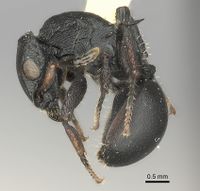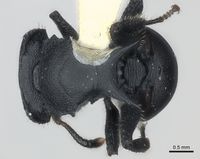Cataulacus huberi
| Cataulacus huberi | |
|---|---|

| |
| Scientific classification | |
| Kingdom: | Animalia |
| Phylum: | Arthropoda |
| Class: | Insecta |
| Order: | Hymenoptera |
| Family: | Formicidae |
| Subfamily: | Myrmicinae |
| Tribe: | Crematogastrini |
| Genus: | Cataulacus |
| Species: | C. huberi |
| Binomial name | |
| Cataulacus huberi André, 1890 | |
| Synonyms | |
| |
Specimens found individuals running on a moss-covered tree trunk in Ghana primary forest. D. Leston collected specimens from this same area (Mt. Atewa) using pyrethrum knock-down sampling. Specimens from other areas have also been found in forest habitats.
Identification
A member of the huberi group Without a doubt Lasius huberi is amongst the most variable of species as concerns sculpturation. It is nonetheless easily recognizable by its combination of the following characters: pedicellar segments transverse and strongly transversely sculptured; gaster with the first tergite strongly marginate and the first sternite carinate laterobasally; sides of head denticulate or crenulate, with a distinct series of projecting hairs. The most closely related species, Cataulacus egenus, is separated by the characters given in the key. (Bolton 1974)
Keys including this Species
Distribution
Known from Democratic Republic of Congo, Ghana, Nigeria, Sierra Leone, and Uganda.
Latitudinal Distribution Pattern
Latitudinal Range: -10.11569° to -10.11569°.
| North Temperate |
North Subtropical |
Tropical | South Subtropical |
South Temperate |
- Source: AntMaps
Distribution based on Regional Taxon Lists
Afrotropical Region: Cameroun, Democratic Republic of Congo, Ghana, Malawi, Nigeria, Sierra Leone (type locality), Uganda, United Republic of Tanzania.
Distribution based on AntMaps
Distribution based on AntWeb specimens
Check data from AntWeb
Countries Occupied
| Number of countries occupied by this species based on AntWiki Regional Taxon Lists. In general, fewer countries occupied indicates a narrower range, while more countries indicates a more widespread species. |

|
Estimated Abundance
| Relative abundance based on number of AntMaps records per species (this species within the purple bar). Fewer records (to the left) indicates a less abundant/encountered species while more records (to the right) indicates more abundant/encountered species. |

|
Biology
|
Castes
Nomenclature
The following information is derived from Barry Bolton's Online Catalogue of the Ants of the World.
- huberi. Cataulacus huberi André, 1890: 326 (w.) SIERRA LEONE. André, 1895a: 4 (q.); Bolton, 1974a: 20 (m.). Senior synonym of guilelmi, herteri, longispinus and material of the unavailable name luebensis referred here: Bolton, 1974a: 19.
- longispinus. Cataulacus huberi var. longispinus Stitz, 1910: 139, fig. 8 (w.) CAMEROUN. Subspecies of huberi: Wheeler, W.M. 1925b: 2. Junior synonym of huberi: Bolton, 1974a: 19.
- herteri. Cataulacus huberi r. herteri Forel, 1913b: 315 (w.) DEMOCRATIC REPUBLIC OF CONGO. Junior synonym of huberi: Bolton, 1974a: 19.
- guilelmi. Cataulacus huberi subsp. guilelmi Wheeler, W.M. 1925b: 1 (w.) DEMOCRATIC REPUBLIC OF CONGO. Junior synonym of huberi: Bolton, 1974a: 19.
Unless otherwise noted the text for the remainder of this section is reported from the publication that includes the original description.
Of the described, and now synonymized infraspecific taxa formerly attached to huberi, the majority were based upon sculptural variations, and these immediately fell into the synonymy. In the var. longispinus, apart from some sculptural variation, Stitz noted that there were three prothoracic spines on each side and relatively long propodeal spines. The latter are well within the range observed during the present study and as has been noted the number of pronotal spines or teeth may vary from 0 to 4. In fact the race herteri, reported by Forel as having no teeth upon the pronotum, has two such processes developed in at least two of the syntype workers in existence. (Bolton 1974)
Description
Worker
Bolton (1974) - TL 5.5 – 7.8, HL 1.22 – 1.74, HW 1.60 – 2.30, CI 127 - 132, EL 0.42 – 0.56, OI 26 - 29, IOD 1.20 – 1.84, SL 0.76 – 1.04, SI 45 - 48, PW 1.28 – 2.10, AL 1.44 – 2.l0, MTL 0.86 – 1.24 (10 measured).
Occipital crest usually developed as an unarmed ridge or acute angle separating vertex from occiput. In shape it may be broadly but shallowly concave across the width of the head or more strongly concave in the middle portion than elsewhere. The crest may be reduced or even absent in some smaller members of the species. Occipital corners acute, usually without a posteriorly projecting tooth but with a laterally projecting dentiform angle. Sides of head behind eyes usually denticulate or crenulate, rarely only irregular. Pronotum strongly marginate laterally, the margination either entire or more usually broken up into 1 to 4 separated, projecting dentiform or blunted processes, sometimes the number of these processes different on each side of the same individual. When the margination is entire then the edge is often crenulate or otherwise jagged. Remainder of alitrunk not marginate, without denticles. Propodeum with a pair of long, acute spines. Dorsal surface of petiole flattened, rectangular or subrectangular in shape, the sides of the posterior face converging. Postpetiole strongly transversely expanded, usually distinctly broader than the petiole. Subpetiolar process well developed, variable in shape and size; subpostpetiolar process usually a long, acute tooth. Both the tergite and the sternite of the first gastral segment strongly or very strongly marginate or carinate laterobasally, these structures tending to fade out before reaching the midlength of the segment.
Sculpturation very variable. The head is usually finely and sparsely reticulate-rugose with reticulate-punctate interspaces, more rarely with the rugulations adopting a longitudinal or arcuate direction. On the dorsal alitrunk all intergrades are known between a distinct longitudinal sulcate-rugulation and a finely shagreened surface with one or two weak rugulae. However, the most common form of sculpturation appears to be a very fine and quite dense longitudinal rugulation with the spaces between the rugulae reticulate-punctate. On the anterior portion of the pronotum the rugulae tend to be transverse. Petiole and postpetiole strongly transversely sulcate-rugose. First gastral tergite usually densely reticulate-punctate, often with numerous longitudinal rugulae, especially basally. Erect hairs absent from dorsal surfaces of head and body, present upon appendages and with a row of distinct short hairs freely projecting laterally beyond the margins of the sides of the head behind the eyes.
Queen
Bolton (1974) - TL 8.0, HL 1.70, HW 2.00, CI 116, EL 0.54, OI 27, IOD 1.68, SL not measurable, PW 1.80, AL 2.30, MTL 1.12.
Answering to the description of the worker but the pronotal marginations not so broadly expanded and the rugulation of the mesoscutellum and propodeum strongly transverse. Propodeal spines greatly reduced in length, present here as a pair of broad, blunt teeth. The female may in fact be as variable as the worker, but collections of this caste are extremely scarce.
Male
Bolton (1974) - TL 6.8, HL 1.20, HW 1.42, CI 118, EL 0.40, OI 28, IOD 1.16, SL 0.66, SI 46, PW 1.36, AL 1.94, MTL 1.02.
Occipital crest absent, the occipital corners projecting as broadly triangular processes. Sides of head behind eyes strongly denticulate. Sides of pronotum sharply but narrowly marginate, not expanded as in the worker, nor armed with teeth. Anterior arms of notauli well developed and strongly cross-ribbed, the posterior arm absent. Parapsidal furrows very distinct. Propodeum with a pair of long, acute spines which are very broad basally. Petiole and postpetiole basically similar in shape to that described for the worker, with similar ventral processes. A faint trace of margination is visible on the first gastral tergite in front of the spiracle, and a short weak carina parallels it upon the sternite. Sculpturation is everywhere of a fine, dense reticulate-puncturation with a few scattered rugulae, which form a loose reticulum behind the eyes. The propodeal dorsum is more strongly rugose and the segments of the pedicel show sculpturation similar to, though less well developed than the worker. Short erect hairs are present and distinct upon the dorsal surfaces of the alitrunk and gaster, but are limited to two upon the vertex.
Type Material
Bolton (1974):
Syntype workers, SIERRA LEONE (A. Mocquerys) (MNHN, Paris) [examined].
Cataulacus huberi var. longispinus. Holotype worker, CAMEROUN: Mundame (Conradt) (MNHU, Berlin) [examined].
Cataulacus huberi race herteri. Syntype workers, ZAIRE: Katanga, Welgelegen 14.vi.1912 (Bequaert) (MHN, Geneva; MRAC, Tervuren; MNHU, Berlin) [examined].
Cataulacus huberi subsp. guilelmi. Holotype worker, ZAIRE: Ituri (location of type not known).
Cataulacus huberi st. herteri var. luebensis. Syntype workers, ZAIRE: Luebo, Kamajembi, 22.iX.1921 (H. Schouteden) (NM, Basle) [examined].
References
- André, E. 1890. Matériaux pour servir à la faune myrmécologique de Sierra-Leone (Afrique occidentale). Rev. Entomol. (Caen) 9: 311-327.
- André, E. 1895a. Formicides de l'Ogooué (Congo français). Rev. Entomol. (Caen) 14: 1-5 (page 4, queen described)
- Bolton, B. 1974a. A revision of the Palaeotropical arboreal ant genus Cataulacus F. Smith (Hymenoptera: Formicidae). Bull. Br. Mus. (Nat. Hist.) Entomol. 30: 1-105 (page 20, male described; page 19, Senior synonym of guilelmi, herteri, longispinus, and material of the unavailable name luebensis referred here)
References based on Global Ant Biodiversity Informatics
- André E. 1890. Matériaux pour servir à la faune myrmécologique de Sierra-Leone (Afrique occidentale). Rev. Entomol. (Caen) 9: 311-327.
- André E. 1895. Formicides de l'Ogooué (Congo français). Rev. Entomol. (Caen) 14: 1-5.
- Bolton B. 1974. A revision of the Palaeotropical arboreal ant genus Cataulacus F. Smith (Hymenoptera: Formicidae). Bulletin of the British Museum (Natural History). Entomology 30: 1-105.
- Bolton B. 1982. Afrotropical species of the myrmicine ant genera Cardiocondyla, Leptothorax, Melissotarsus, Messor and Cataulacus (Formicidae). Bulletin of the British Museum (Natural History). Entomology 45: 307-370.
- Forel A. 1913. Formicides du Congo Belge récoltés par MM. Bequaert, Luja, etc. Revue Zoologique Africaine (Brussels). 2: 306-351.
- Santschi F. 1910. Formicides nouveaux ou peu connus du Congo français. Annales de la Société Entomologique de France 78: 349-400.
- Wheeler W. M. 1922. Ants of the American Museum Congo expedition. A contribution to the myrmecology of Africa. VIII. A synonymic list of the ants of the Ethiopian region. Bulletin of the American Museum of Natural History 45: 711-1004
- Wheeler W. M. 1925. Zoological results of the Swedish Expedition to Central Africa 1921. Insecta. 10. Formicidae. Arkiv för Zoologi 17A(25): 1-3.


